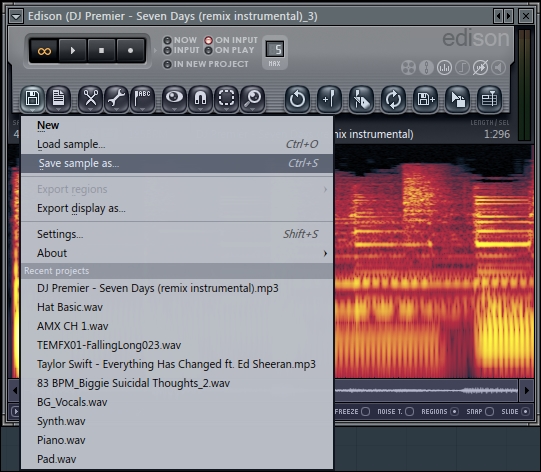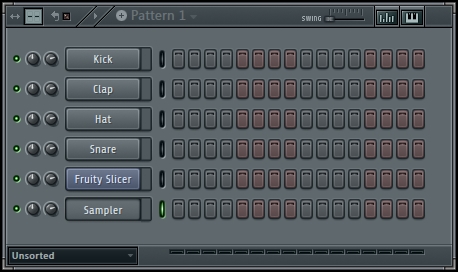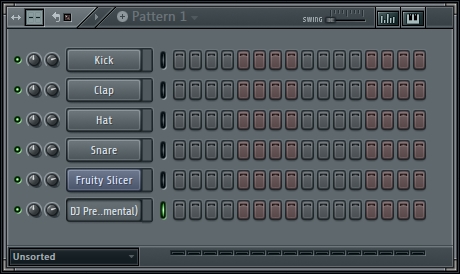Importing your new saved sample can be achieved in various ways, much like there are many ways to skin a cat. It basically depends on your own personal workflow and the ways in which you feel most comfortable with the program. When inspiration strikes, you may want to drag files out of Edison and into your step sequencer as quickly as possible. However, at some point, you should make sure your files are retrievable and saved in the proper manner. You may need them as a reference for clearance purposes or even to use them again a second time around.
In order to import your new, saved sample from Edison into your FL Studio project, you will want to have Edison open and your sample edits and parameters saved. It doesn't matter if you have a loop, embedded tempo, or simply a one-shot small section highlighted. The method of importing is the same.
Let's us review the steps required to import your new saved sample.
- Click on the disk icon inside of Edison and select Save sample as…, as shown in the following screenshot:

Fig 7.20
- Browse/save your file to a location or folder that is best for your workflow.
- Select CHANNELS from the top of the main FL Studio window, hover your mouse on Add one, and select a Sampler channel, as shown in the following screenshot:

Fig 7.21
- A new Sampler channel will be created in the step sequencer as shown in Fig 7.22. This is simply a blank channel that says Sampler.

Fig 7.22
- Click on the small folder icon directly under the SMP tab within your sampler's Channel settings. This will open up another window where you can browse and retrieve your saved sample. Once retrieved, the area to the right of the small folder icon will change to your sample name and the bottom of your channel will show the waveform.
You may also use FL Studio Browser (F8) to scroll through your saved samples as well as drag files over from a separate window into FL Studio. If you are using FL Studio Browser in this manner and you are saving files to an external hard drive or somewhere not inside the FL Studio, make sure your FL Studio Browser extra search folders include the proper locations. This setting can be found by pressing F10 and clicking on
FILE. The following screenshot shows the settings in the SMP tab:
Fig 7.23
- The name of your channel will automatically change to the sample you have selected, as shown in Fig 7.24. It will squeeze as much text as possible into the CHANNEL view on the step sequencer. Hover your mouse on the channel and look at the FL Studio hint bar to see the full name of your channel.

Fig 7.24
When saving your file to your computer or external hard drive, FL Studio defaults your saved file into the Microsoft WAV file format. You have the ability to change this to a Microsoft-compressed WAV file, WavPack audio file, MP3, or OggVorbis by using the Save as type drop-down box before saving. You can also set your folder location as a favorites by using the + sign next to the Favorites area. If you have an external drive, make sure your drive is connected to your computer, or it will not bring up the drive location.
Remember that when working with the step sequencer, you can easily add a new channel by right-clicking on any channel in the step sequencer and then selecting Insert. This avoids the need to go to the main CHANNELS menu.
You may also save your file to a location inside of the FL Studio Browser. In this manner, when your browser is refreshed, you can choose your files from inside the browser. The computer hierarchy to save your files in the browser is reviewed in Chapter 2, Using Browser.
You can also simply use the Drag / copy sample / selection or Send to playlist as audio clip / to channel button in Edison. Additionally, you can drag your waveform from the bottom of your Channel settings into the FL Studio Playlist. There are many options available when working with Edison and it all depends on your personal workflow.
